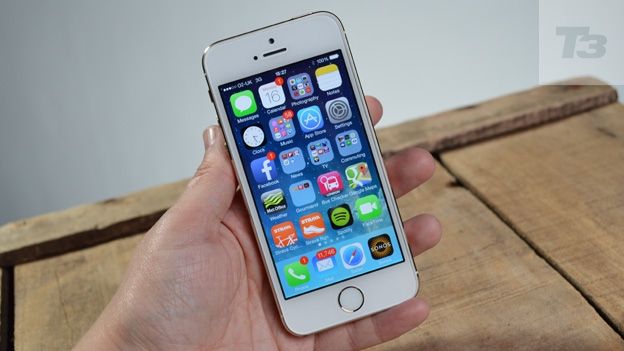iPhone 5S review: the SE may be here but this is still a cracking budget 4-inch phone
The iPhone 5S was at one point Apple's most powerful phone, but no more!


-
+
Touch ID
-
+
Improved camera and flash
-
+
Wide LTE support
-
-
Price
-
-
Battery life
Why you can trust T3






















Update: The iPhone 5S has been ousted by the iPhone SE - check out our iPhone SE review.
This is Apple's 2013 flagship device, now much more affordable. The iPhone 5S still has a lot going for it, especially if you're a fan of the compact 4-inch display and are looking to save a bit of cash.
The iPhone 5S was at one point Apple's most powerful phone, though that award has now been handed over to the iPhone 6 and 6 Plus, but it still packs a punch and shouldn't instantly be discounted because it's a little on the old side.
Now firmly in the mid-range, the iPhone 5S has a playground of worthy rivals to battle with like the HTC One Mini 2 and Samsung Galaxy S5 Mini and even low priced devices like the Motorola Moto G (2014), does it still hold its own?
iPhone 5S: Features
Unquestionably, the standout features of the iPhone 5S are its hardware inclusions and upgrades, namely Touch ID, the M7 motion co-processor, 64-bit architecture and the iSight camera.
Now, fingerprint scanning is a pretty boring subject and our only real day-to-day experience of using the technology is with those digit readers built into laptops – a slide-to-unlock affair that worked 60% of the time.
So, when Apple bought AuthenTec, spawning rumours of similar technology being integrated into its devices, we weren't exactly enamoured. However, Apple has done its age-old trick of turning a dull feature into something resembling sexy.
Introduced to replace passcode authentication for unlocking the phone and making iTunes purchases, Touch ID is a joy to use. The sensor is built right into the Home button and registration of a thumb, finger or both – five digits can be registered – takes about a minute using a most-pleasing enrolment system.
Once recorded, Touch ID has 360-degree, readability of registered digits, meaning it'll unlock your phone no matter what way up you're holding the handset. The key selling point, however, is the simplicity and speed of identification.
Check out our iPhone 5s Touch ID demo walkthrough video:
You don't have to use Touch ID, but after a few hours with it, the mere thought of entering a four-digit passcode to unlock the device seemed so passé. And this is so easy.
Apple is keen to point out that it doesn't store fingerprint details in iCloud or any of its remote servers. It's all contained within the hardware, meaning nobody can get at your data. Even the NSA.
With iOS 8 you can also use TouchID to replace the passcode for opening many third-party apps, like password manager 1Password and this is a feature we love.
Like the GPU that bears the graphical strain from a computer's processor, the M7 Coprocessor takes the weight of motion measurements - compass, accelerometer and gyroscope - away from the A7 CPU.
Apple claims this will provide a 6x power saving for (iOS 7 and 8-updated) apps that record motion - Nike+, Strava, Moves, etc - but this dedicated chip can also tell what state of movement you're in and will adjust the iPhone 5S accordingly.
To test this, we used Apple Maps to plot an A to B route that required driving and walking. Upon reaching our destination, and exiting the car, the navigation switched from car to foot, taking us down one-way streets that wouldn't have been possible in a motor.
If the Coprocessor is clever enough to know where you are and what you're doing (to an extent), it could pave the way for the next wave of apps and features. One example we were given was this: if your iPhone 5S is put in a gym locker while you pump iron, it knows that a) you're not using it b) there's no network coverage c) it's stationary.
The iPhone could then power itself right down, switching off 3G/4G, the screen and so forth until the time it's picked up again, where it would come back to life, ready to take that call from your PT asking why you sat in the sauna for two hours rather than making yourself sick doing burpees.
Another improvement over the iPhone 5 is the A7 CPU/64-bit architecture combo. On paper, Apple claims the power couple will deliver speed twice that of the A6 chip and vastly improved OpenGL ES 3.0-compatible graphics.
In the 12 months since the the iPhone 5S was released, a number of apps and games have been released that can really push the 64-bit hardware, though we're expecting a lot more now the iPhone 6 is here packing a faster A8 64-bit chip.
Even with the release of the iPhone 6, the iPhone 5S doesn't feel sluggish, in fact the iOS 8 update speeds up animations and overall performance.
For a while Apple was the only company in the game producing 64-bit mobile devices, but in recent weeks we've seen a few running Android see the light of day. Both the Nexus 9 and Nvidia Shield Tablet use the tech and Android 5.0 Lollipop supports it natively, though we might have to wait until 2015 for a raft of phones using it.
We can report that the A7 chip has definitely made the Camera app a lot zippier on the iPhone 5S. Real-time previews, on-the-fly effects processing, slo-mo, autofocus (see more in iSight, below) are faster and free from lag or judder. For us, this app demonstrates the most noticeable speed improvement in the iPhone 5S's armory.
iPhone 5S: Camera
The other evident area of improvement over the iPhone 5 and differentiation between the 5c lies with the new iSight camera. Rather than upping the megapixel count, to match that of the Sony Xperia Z and Samsung Galaxy S4 and the staggering 41MP on the Nokia Lumia 1020, Apple has opted to increase the 8MP (the same megapixel count as the iPhone 6 and 6 Plus) sensor by 15% and individual pixels to 1.5 microns. The aperture has also had a spec bump to f/2.2, increasing light sensitivity by 33%.
While that's all well and good on paper, it's in the wild where these claims count. Mercifully, in Apple's case, the results are noticeable.
There's a new sense of depth to shots, especially with close-up subjects but It doesn't quite have the low-light performance of the iPhone 6 and 6 Plus, due to the lack of image stabilisation. It still manages to compete with the top devices on the market though, which you can't say for many phones released over a year ago.
iPhone 5s camera test video:
Other iPhone 5S-specific camera features include; auto image stabilisation (steady), 3x video zoom (bit blurry), 30fps panorama with varying light control (megabyte-y), burst mode at 10 photos per second (cheeky) and, best of all, slo-motion video capture, which is absolutely brilliant. It's the iPhone 5S's Panorama moment and you can expect to see your social feeds filling up with quarter-speed 120fps 720p footage very shortly.
The fact that the iPhone 5S can process it all on the fly is testament to the A7 chip. Video quality is outstanding and, even if capturing your child's meteoric face-plant (we speak from experience), all emotional guilt is washed away as you become Spielberg for a second, seizing every last crunch in superb clarity and detail. Disclaimer: no children were harmed in the testing of this iPhone.
Another vast improvement is with the front-facing FaceTime HD camera. An improved backside illumination sensor improves video calls in lower light and still shots look cleaner than ever. Video records in 720p.
iPhone 5S: Screen
Swanking the same 4-inch, 1136x640 at 326ppi screen as its predecessor, and matching that of the 5C, the iPhone 5S display feels small in comparison to the Samsung Galaxy S5 (5.1-inch), the HTC One M8 (5-inch) and even the bargain priced Moto G (2014) (5-inch).
Screen quality is pin-sharp but, after watching films on the iPhone 6 and 6 Plus, which have 4.7 and 5.5-inch Retina HD screens respectively, you really notice the drop in size and resolution. However, the Retina screen really shows off iOS 8's bright UI, with popping colours and inky blacks.
iPhone 5S: Size and build
The iPhone 5S is basically a supercharged iPhone 5, so the weight, size and overall build are pretty much identical – 7.6mm deep, 123.8mm tall and 112g in bulk. That makes it slimmer than the HTC One M8 and Samsung Galaxy S5, but not quite as slender as the iPhone 6, which measures in at 6.9mm.
It's still lightweight but feels reassuringly premium with its three colour variants - Gold, Silver and Space Grey – adding to the mix and differentiating it once more from the colour-coordinated 5C.
The Gold finish may be too bling-y for some but if it suffers the same chamfered edge scuffing as its predecessor, a lighter colour will conceal it better than the darker Silver and Space Gray.
Apple is selling its own dyed leather iPhone 5S case in a multitude of shades for £35, which turns it into a 5C-looking device, but if we were splashing out more bunce on the flagship model, we'd rather forgo the jacket and show it off.
iPhone 5S: Performance
Using the iPhone 5S is a joy. Multi-tasking is quick, navigation is innate and it still feels slicker than Windows Phone or Android, though we may have to reassess this once we've had a good play around 5.0 Lollipop.
Phone calls are clear and we didn't experience any call-dropping in our testing. Sound quality is on par with the iPhone 5, but wireless connectivity (Bluetooth and Wi-Fi) seems to be a bit more stable than before - Personal Hotspot connected a lot quicker, too.
The iPhone 5S is available in 16GB and 32GB versions, with the 64GB option dropped with the introduction of the iPhone 6 and 6 Plus. (see price below).
iPhone 5S: iOS 8
Within the iPhone 5S and each new device shipping with iOS 8, you get Apple's iWork apps - Pages, Numbers and Keynote – for free.
Swiping down on the homescreen reveals the Search bar, while swiping apps up while in multi-tasking view will close apps.
Swipe up on the homescreen and you'll be presented with a handy shortcut of features ranging from activating Aeroplane mode to adjusting brightness to turning on the torch.
iOS 8 also brings with it plenty of other updates, including handy widgets in the notification tray, apps that can finally talk to each other (editing photos with a third-party app, right from the native Photos app) and plenty of new tools for developers to play around with. Our favourite new addition though is Continuity, which brings iOS and OSX closer together, letting you start a message on your phone and pick it straight up on your Mac. It's clever and actually works like a charm.
iPhone 5S: 4G
The iPhone 5S has a wider range of LTE bands that every UK provider should be able to support. We tested the 5s on EE's 4G network and, like the iPhone 5, experienced blisteringly fast internet connections and downloads.
Of course, your actual speeds will depend on a wide breadth of parameters, but you should hope to achieve uploads and download speeds in excess of 15/20Mbps.
The pace of LTE really proves its worth when using FaceTime HD and streaming content.
iPhone 5S: Battery
Apple quotes ten hours talk time on 3G, 250-hours in standby, ten hours of internet use on 3G, LTE and Wi-Fi, with video playback running to 10 hours and audio stretching to 40 hours.
In our real-world testing, we found the iPhone 5S mimics that of its predecessor – great in standby, draining when using 3G/4G and performing graphically intensive tasks. For example, we started the day (10.20am) with 82% of battery and after a 20-minute TomTom navigation, an hour's worth of on/off slo-motion and regular video and photo capture, and a bit of web surfing, by 12.37am we were down to 4% and in desperate need of a recharge.
In terms of the competition, the iPhone 5S definitely falls behind when put up against devices boasting large batteries, like the LG G3 and Samsung Galaxy Note 4 and can't keep up with the iPhone 6, let alone the 6 Plus.
iPhone 5S: Verdict
Apple is clearly looking to future-proof its handset while offering developers the opportunity to take advantages of its 64-bit architecture, A7 chip and M7 Coprocessor.
But, as ever, you're going to have to pay for the privilege. Off contract and SIM-free, prices range from £459 for the 16GB model to £499 for the 32GB version. While the price has dropped since release, it is far from the best value smartphone around. For example, the upcoming Nexus 6 packs a 6-inch 2K display, Snapdragon 805 processor, 13mp snapper and Android 5.0 Lollipop and costs £499, again with 32GB of internal storage.
The iPhone 5S is still a great phone, with a fantastic camera, TouchID and a 64-bit processor that still isn't common place today.
iPhone 5S release date: Out now
iPhone 5S price: £459 (16GB), £499 (32GB)
Sign up to the T3 newsletter for smarter living straight to your inbox
Get all the latest news, reviews, deals and buying guides on gorgeous tech, home and active products from the T3 experts
-
 Netflix's new show Ransom Canyon is coming for Yellowstone's lunch money
Netflix's new show Ransom Canyon is coming for Yellowstone's lunch moneyIt's precision-targeted
By Max Freeman-Mills Published
-
 New Matter leak reveals exciting smart garden tools heading our way – a lot sooner than expected
New Matter leak reveals exciting smart garden tools heading our way – a lot sooner than expectedThat was pretty unexpected!
By Lizzie Wilmot Published
-
 HBO’s best sci-fi in recent memory returns for season 2 in just two weeks
HBO’s best sci-fi in recent memory returns for season 2 in just two weeksThe Last of Us season 2 airs on 13 April – I'm counting down the days
By Mike Lowe Published



